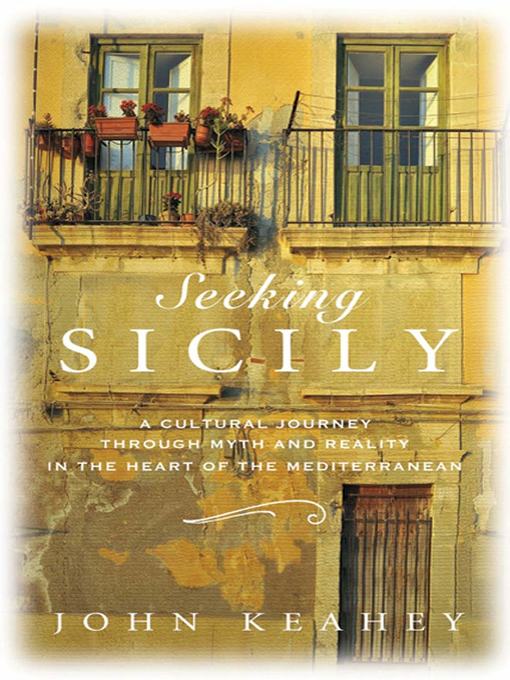
Seeking Sicily
A Cultural Journey Through Myth and Reality in the Heart of the Mediterranean
- اطلاعات
- نقد و بررسی
- دیدگاه کاربران
نقد و بررسی

August 8, 2011
When travel writer Keahey first visited Sicily in 1986, he discovered that it hardly resembled the bucolic images of peasant men and women hauling huge piles of newly harvested grapes or of donkey carts carrying oversized milk cans. Disappointed, he began his search for the Sicily of an earlier era and found it in the pages of numerous 19th- and early 20th-century novelists and essayists. Seeking to understand better the richness of Sicilian culture and its 3,000-year history, Keahey visited Sicily four times between March 2009 and March 2010 to see the island in various seasons. He sets out to capture Sicily through conversations with islanders and by studying their writers and their myths. For example, Keahey weaves Giovanni Verga’s short stories about the carts used to carry people on rough 19th-century roads with the story of Franco Bertolino, the last of the traditional Sicilian cart painters; Bertolino is at once nostalgic and resigned to this closing chapter of Sicilian history. Keahey ranges widely over topics from language and festivals to food and the Mafia. He points out that the Sicilian language has no future tense, surmising that was likely due to Sicilians having long been occupied by other empires and had no hope of having an independent future. Keahey’s journey is a rich guide to the culture and history of Sicily.

October 1, 2011
Veteran newspaperman Keahey continues his exploration of Italian civilization with an appreciation of the rich, vibrant surroundings of Italy's largest autonomous island. Having previously explored both the Ionian Sea region and the disastrous fate of an ever-sinking Venice (Venice Against the Sea: A City Besieged, 2002), the author turns his journalistic eye toward Sicily, a "strange, magnificent, brooding island." Keahey meticulously observes the history, colorful customs and culture of Sicilians with boundless curiosity. He climbs the rickety scaffolding in capital city Palermo to capture the best view of the palazzo compound of taciturn Sicilian novelist Giuseppe di Lampedusa. He shares a stroll through a cuisine cornucopia at Vucciria marketplace and observes the region's many unwieldy, grandiose festivals and processions honoring patron saints and Easter Week. After illuminating the island's varying economic strata, Keahey retraces the fascinating history of village squares once used for public burnings and the restoration of a local prison. Some of his sightseeing is informally guided by indigenous "Siciliani," an assemblage of prideful natives whose characteristics the author describes with the same spirited deliberation as chapters on myths, food, native dialects and the histrionics of the Sicilian Mafiosi. In a superbly sensory chapter, Keahey marvels at variations in Sicilian cuisine with mouthwatering descriptions flooding the pages of this lush travelogue. With extensive details and a fond admiration of its people, Keahey effectively articulates why the people of this charming island "are Sicilians before they are Italians, and why no amount of time under the control of Rome will ever change that."
(COPYRIGHT (2011) KIRKUS REVIEWS/NIELSEN BUSINESS MEDIA, INC. ALL RIGHTS RESERVED.)

November 1, 2011
Keahey (Venice Against the Sea; A Sweet and Glorious Land: Revisiting the Ionian Sea) takes a meandering and inspiring tour through the history, culture, and landscape of Sicily, an island that has been a crossroads for the various peoples of the Mediterranean for millennia. Known to many Americans as the birthplace of the Mafia, Sicily has, through the centuries, been ruled by the ancient Greeks and Romans, Normans, and Arabs, among others, and its language, food, and architecture exhibit influences of its visitors and invaders. Keahey also examines the island through the words of several contemporary Sicilians, most notably the author Leonardo Sciascia. VERDICT Keahey's thoroughly researched book will inspire any traveler to look past the Sicily of the traditional tourist's guide and appreciate its diverse, layered, and sometimes dark history. Armchair travelers will also want to dip into many of the books Keahey references, including those by Sciascia, a number of which have been translated into English (e.g., The Day of the Owl; To Each His Own). (Several recipes are included; maps and photographs not seen.)--Linda M. Kaufmann, Massachusetts Coll. of Liberal Arts Lib., North Adams
Copyright 2011 Library Journal, LLC Used with permission.

September 15, 2011
Outsiders will never comprehend the Sicilian psyche, Keahey concludes after exploring the Italian island, from the craters of Mount Etna to the kitchens of Palermo. This unsentimental travel memoir does, however, explain why the people of Sicily are Sicilians before they are Italians, and why no amount of time under the control of Rome will ever change that. What makes the ride through this strange, magnificent, brooding island so bouncy is the way Keahey can shift swiftly from, say, a hard-nosed investigation into the origins of the Mafia to a mouthwatering chapter on Sicilian cooking, complete with recipes and an explanation of the Arab origins of cannoli. He peppers the trip with tidbits from some of the best literature about Sicily and balances his joyful participation in island rituals and festivals with serious analysis of such shameful episodes as widespread child labor in the sulfur mines, which lasted into the twentieth century. Although the power of family is deeply ingrained in Sicilians, its manifestations are as complicated as its Greek, Roman, Carthaginian, Spanish, and Norman lineage.(Reprinted with permission of Booklist, copyright 2011, American Library Association.)




دیدگاه کاربران